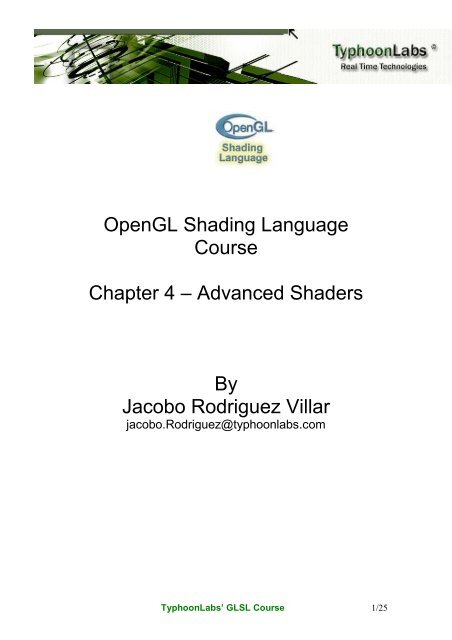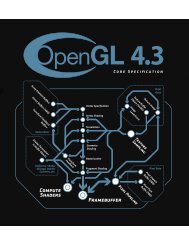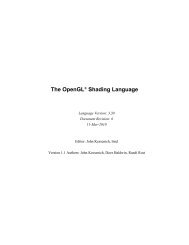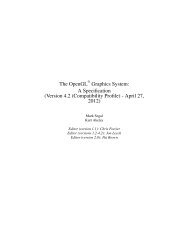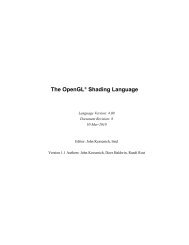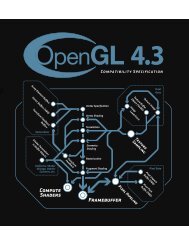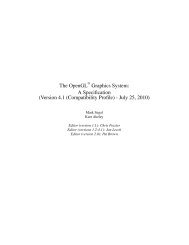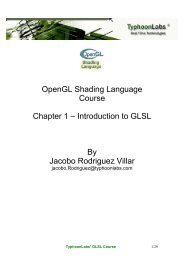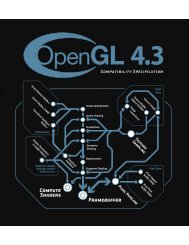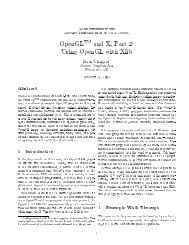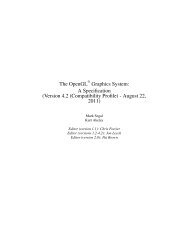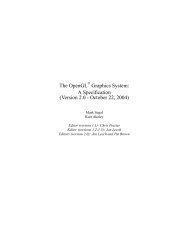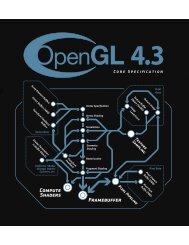OpenGL Shading Language Course Chapter 4 â Advanced Shaders ...
OpenGL Shading Language Course Chapter 4 â Advanced Shaders ...
OpenGL Shading Language Course Chapter 4 â Advanced Shaders ...
You also want an ePaper? Increase the reach of your titles
YUMPU automatically turns print PDFs into web optimized ePapers that Google loves.
<strong>OpenGL</strong> <strong>Shading</strong> <strong>Language</strong><br />
<strong>Course</strong><br />
<strong>Chapter</strong> 4 – <strong>Advanced</strong> <strong>Shaders</strong><br />
By<br />
Jacobo Rodriguez Villar<br />
jacobo.Rodriguez@typhoonlabs.com<br />
TyphoonLabs’ GLSL <strong>Course</strong> 1/25
<strong>Chapter</strong> 4: <strong>Advanced</strong> <strong>Shaders</strong><br />
INDEX<br />
Introduction 2<br />
Per Pixel Illumination Model 2<br />
Bump Mapping 9<br />
Simple Parallax Shader 15<br />
Mandelbrot Shader (Flow Control) 19<br />
<strong>Advanced</strong> Illumination Model 22<br />
TyphoonLabs’ GLSL <strong>Course</strong> 2/25
INTRODUCTION<br />
This chapter will focus on advanced illumination algorithms and other<br />
miscellaneous items like fractal computing, displacement shaders, and Perlin<br />
Noise usage. You should be confident with the material in all previous chapters<br />
before reading further.<br />
Per Pixel illumination Model (point light, amb, dif, spec*gloss)<br />
The theory for this shader was covered in the last two chapters, so here we will<br />
only cover what changes need our code in order to achieve per pixel lighting<br />
rather than per vertex lighting.<br />
First, fill the property grid values with the same information as the last shader<br />
(specular * gloss mapping tutorial) and insert two uniforms (texture and camera<br />
position).<br />
[Vertex shader]<br />
varying vec3 normal;<br />
varying vec3 position;<br />
void main()<br />
{<br />
gl_Position = ftransform();<br />
gl_TexCoord[0] = gl_TextureMatrix[0] * gl_MultiTexCoord0;<br />
normal = gl_Normal.xyz;<br />
position = gl_Vertex.xyz;<br />
}<br />
It is easy to see that we’ve removed all code related to the light computations.<br />
Here only the future values needed for the fragment shader are computed and<br />
passed to it.<br />
TyphoonLabs’ GLSL <strong>Course</strong> 3/25
[Fragment shader]<br />
uniform sampler2D texture;<br />
uniform vec3 CAMERA_POSITION;<br />
varying vec3 normal;<br />
varying vec3 position;<br />
void main()<br />
{<br />
vec4 specular = vec4(0.0);<br />
vec4 diffuse;<br />
vec3 norm = normalize(normal); //Important: after interpolation normal modulus != 1.<br />
vec3 lightVector = gl_LightSource[0].position.xyz - position;<br />
float dist = length(lightVector);<br />
float attenuation = 1.0 / (gl_LightSource[0].constantAttenuation +<br />
gl_LightSource[0].linearAttenuation * dist +<br />
gl_LightSource[0].quadraticAttenuation * dist * dist);<br />
lightVector = normalize(lightVector);<br />
float nxDir = max(0.0, dot(norm, lightVector));<br />
diffuse = gl_LightSource[0].diffuse * nxDir * attenuation;<br />
if(nxDir != 0.0)<br />
{<br />
vec3 cameraVector = normalize(CAMERA_POSITION - position.xyz);<br />
vec3 halfVector = normalize(lightVector + cameraVector);<br />
float nxHalf = max(0.0,dot(norm, halfVector));<br />
float specularPower = pow(nxHalf, gl_FrontMaterial.shininess);<br />
specular = gl_LightSource[0].specular * specularPower * attenuation;<br />
}<br />
vec4 texColor = texture2D(texture, gl_TexCoord[0].st);<br />
gl_FragColor = gl_LightSource[0].ambient +<br />
(diffuse * vec4(texColor.rgb,1.0)) +<br />
(specular * texColor.a);<br />
}<br />
This fragment shader contains all the computations that were removed from the<br />
vertex shader, but there are few things that are important to mention:<br />
First, in the vertex shader it wasn’t necessary to normalize normals because<br />
they were normalized , but here, the normals have been interpolated, so their<br />
values have changed, and the normalization is obligatory.<br />
Secondly, we have to pass the interpolated vertex position in order to know the<br />
true fragment position by computing the exact vectors from light or camera to<br />
the fragment.<br />
In this shader there are many possible optimizations. For example, move back<br />
the attenuation factor computation to the vertex shader and pass it interpolated.<br />
Moving calculus from the fragment shader to the vertex shader always has the<br />
same result: it improves the speed (unless you have more vertices than<br />
fragments, but that is very unusual) and reduces the quality.<br />
TyphoonLabs’ GLSL <strong>Course</strong> 4/25
Let’s see the difference between per pixel lighting and per vertex lighting:<br />
Per vertex lighting<br />
Per pixel lighting<br />
The difference is obvious, but the best thing is that the tessellation size of the<br />
mesh doesn’t matter for per pixel lighting. Still, there is a drawback: per pixel<br />
lighting shader is much more expensive than per vertex.<br />
Here is this shader complete:<br />
Notice the nice specular effect, and the dirty surface obscuring some parts.<br />
TyphoonLabs’ GLSL <strong>Course</strong> 5/25
Here are some screenshots showing how the different light components affect<br />
the final render:<br />
Ambient = (51,51,51,); Diffuse = Specular = (255,255,255);<br />
Front Material Shininess = 64 Light Position = (0,0,2)<br />
Per Vertex Lighting<br />
Ambient<br />
Diffuse<br />
Ambient + Diffuse<br />
Ambient + Diffuse * texture<br />
TyphoonLabs’ GLSL <strong>Course</strong> 6/25
Specular<br />
Specular * gloss<br />
Diffuse + Specular<br />
Diffuse * texture + Specular<br />
TyphoonLabs’ GLSL <strong>Course</strong> 7/25
Per Pixel Lighting<br />
Ambient<br />
Diffuse<br />
Ambient + Diffuse<br />
Ambient + Diffuse * texture<br />
Specular<br />
Specular * gloss<br />
TyphoonLabs’ GLSL <strong>Course</strong> 8/25
Diffuse + Specular<br />
Diffuse * texture + Specular<br />
Choose for yourself which lighting model is better.<br />
TyphoonLabs’ GLSL <strong>Course</strong> 9/25
Bump Mapping<br />
Bump mapping is probably the most famous lighting effect. What is bump<br />
mapping? To answer this question, an explanation of shading models is in<br />
order. Let’s see what happens with each one:<br />
Vertex: Light: Normal:<br />
Flat shading<br />
Goraud shading<br />
triangle<br />
Only the first normal of the triangle is used<br />
to compute lighting in the entire triangle.<br />
Phong shading<br />
The light intensity is computed at each<br />
vertex and interpolated across the surface.<br />
Bump mapping<br />
Normals are interpolated across the<br />
surface, and the light is computed at each<br />
fragment.<br />
Normals are stored in a bumpmap texture,<br />
and used instead of Phong normals.<br />
Until now, we’ve only implemented Goraud and Phong shading; now it's time to<br />
do some bump mapping.<br />
In order to have enough information for our shader to be able to compute bump<br />
mapping lighting effects, we need to define a “normal map.” A normal map is a<br />
texture that holds the normals that must be applied to every fragment of a base<br />
texture. That is, if we have a base texture, we also need its bump map.<br />
The real maths needed to create a normal map are beyond the purposes of this<br />
document, and we will explain the process in a high-level language. A normal<br />
map can be built two ways: first, with a high poly model (there are plug-ins for<br />
the most common DCC applications that can compute the normals of a 3D high<br />
tessellated model and put them into a texture file) and secondly, having the<br />
height map of the model (or a height map for a base texture). A height map is<br />
TyphoonLabs’ GLSL <strong>Course</strong> 10/25
nothing more than a greyscale texture that holds the height of every pixel. For<br />
example:<br />
Base texture<br />
Height map<br />
With some math tricks (i.e. taking derivatives on adjacent texels to get the<br />
normal at each texel), a height map can be turned into a normal map.<br />
Normal Map<br />
The normals are scaled and translated (because a normal can have negative<br />
values, and a GL_UNSIGNED_BYTE texture can’t either) to the range [0,255]<br />
and then encoded into RGB pixels ( 127.5 * (normal XYZ + 1.0) RGB ubyte).<br />
Then, when we read the normal map (it is automatically scaled and translated to<br />
[0,1], as all textures are, into a fragment shader), we only need to do this: vec3<br />
normal = texture2D(myNormalMap, texcoord.st).xyz * 2.0 – 1.0; and we will<br />
have the normal in the range [-1,+1] again and ready to be used.<br />
There is one important thing before continuing, which makes this very complex.<br />
Those normals are not in the same space as the light vector, so we need to<br />
compute the light vector in the vertex shader, translate to the same space that<br />
the normals are in, and pass this light vector interpolated to the fragment<br />
TyphoonLabs’ GLSL <strong>Course</strong> 11/25
shader. But what new space is this, and how we can translate our light vector to<br />
this space?<br />
It is called “Tangent Space,” and it is defined for each face of the mesh. We<br />
need this space because it allows us to keep the normals unchanged. For<br />
example, if we store the normals in object space, when we rotate the model, we<br />
have to rotate the normals too, to maintain coherency. However, with the<br />
normals relatives to each face, this is not needed. Those normals are<br />
independent of the model orientation and position.<br />
In order to build this Tangent Space, we need to define an orthonormal pervertex<br />
basis, which will define our tangent space. To build this basis we need<br />
three vectors. We already have one of them: the vertex Normal. The other<br />
vector has to be tangent to the surface at the vertex (that’s why this space is<br />
called Tangent Space). This vector is the Tangent vector. The last one can be<br />
obtained with the cross product of the normal and the tangent vector, and is<br />
called the Binormal vector. The computation of the tangent vector is quite<br />
complicated. It won't be explained here, but Shader Designer provides both<br />
Tangent and Binormal attributes automatically, as well as providing normals and<br />
texture coordinates.<br />
To convert our incoming light vector to tangent space we need to build a matrix<br />
that holds the three vectors and multiply by it.<br />
Tx Ty Tz<br />
mat3 TBN =<br />
Bx By Bz<br />
Nx Ny Nz<br />
Vector S = surface local vector, Vector O = object space vector<br />
Tx Ty Tz<br />
Sx, Sy, Sz = Ox, Oy, Oz * Bx By Bz<br />
Nx Ny Nz<br />
Our object space vector will be in tangent space.<br />
Now we must setup our variables and textures. First, load two textures with the<br />
textures dialog. Place in texture unit 0 the base texture (for example,<br />
mur_Ambiant.bmp) and place in texture unit 1 the normal map<br />
TyphoonLabs’ GLSL <strong>Course</strong> 12/25
(mur_NormalMap.bmp). Create two uniforms for these two textures, as well as<br />
the CAMERA_POSITION predefined uniform.<br />
In order to get a relevant (but not very realistic) specular effect, type 64 into the<br />
front material shininess. Next put the light at (0,0,2) and the diffuse contribution<br />
to (255, 255, 128) (a little yellow).<br />
Those values are not too realistic, but are there to increase the bump effect, for<br />
teaching purposes.<br />
Because Shader Designer automatically computes the tangent and binormal<br />
attributes, there are no more steps.<br />
Now, let’s code our vertex shader for the bump mapping effect<br />
[Vertex shader]<br />
attribute vec3 tangent;<br />
attribute vec3 binormal;<br />
varying vec3 position;<br />
varying vec3 lightvec;<br />
void main()<br />
{<br />
gl_Position = ftransform();<br />
gl_TexCoord[0] = gl_TextureMatrix[0] * gl_MultiTexCoord0;<br />
position = gl_Vertex.xyz;<br />
mat3 TBNMatrix = mat3(tangent, binormal, gl_Normal);<br />
lightvec = gl_LightSource[0].position.xyz - position;<br />
lightvec *= TBNMatrix;<br />
}<br />
Here, the data is prepared to feed the fragment shader. First, we will compute<br />
the usual variables (vertex position and texture coordinates), then create our<br />
TBN matrix with the tangent and binormal data. Finally, we compute the light<br />
vector in tangent space.<br />
TyphoonLabs’ GLSL <strong>Course</strong> 13/25
[Fragment shader]<br />
uniform sampler2D base;<br />
uniform sampler2D normalMap;<br />
uniform vec3 CAMERA_POSITION;<br />
varying vec3 position;<br />
varying vec3 lightvec;<br />
void main()<br />
{<br />
vec3 norm = texture2D(normalMap, gl_TexCoord[0].st).rgb * 2.0 - 1.0;<br />
vec3 baseColor = texture2D(base, gl_TexCoord[0].st).rgb;<br />
}<br />
float dist = length(lightvec);<br />
vec3 lightVector = normalize(lightvec);<br />
float nxDir = max(0.0, dot(norm, lightVector));<br />
vec4 diffuse = gl_LightSource[0].diffuse * nxDir;<br />
float specularPower = 0.0;<br />
if(nxDir != 0.0)<br />
{<br />
vec3 cameraVector = normalize(CAMERA_POSITION - position.xyz);<br />
vec3 halfVector = normalize(lightVector + cameraVector);<br />
float nxHalf = max(0.0,dot(norm, halfVector));<br />
specularPower = pow(nxHalf, gl_FrontMaterial.shininess);<br />
}<br />
vec4 specular = gl_LightSource[0].specular * specularPower;<br />
gl_FragColor = gl_LightSource[0].ambient +<br />
(diffuse * vec4(baseColor.rgb,1.0)) +<br />
specular;<br />
The first thing to notice here is that the attenuation computation has been<br />
removed, because we want this shader to be as simple as possible.<br />
The rest of the shader is fairly simple. First, we read the base texel and the<br />
normal for this texel. Then we scale and translate it to the range [-1,1] ( * 2.0 –<br />
1.0 scale and bias).<br />
The only difference with this shader and the last one (per pixel lighting) is the<br />
way we compute the light vector and the normal. In the per pixel shader, the<br />
light vector was in object space, and the normal was interpolated. Here the light<br />
vector is in tangent space, and the normal is extracted from a texture. For<br />
everything else, the computations remain the same.<br />
TyphoonLabs’ GLSL <strong>Course</strong> 14/25
Here are some screenshots of the bump map shader, though the best way to<br />
notice this effect is with moving lights. Use the rotate light feature to see it, and<br />
play with the diffuse and specular components of gl_FragColor, to see how it<br />
affects them individually (for example, gl_FragColor = diffuse *<br />
vec4(baseColor,1.0);).<br />
Notice the ‘volume’ feeling<br />
Looks like plastic? Reduce specular and<br />
add a gloss map<br />
TyphoonLabs’ GLSL <strong>Course</strong> 15/25
Simple Parallax Mapping shader<br />
We’ve seen two advanced lighting shaders that can add a great deal of<br />
complexity and realism to our scenes, but when the camera gets closer to the<br />
surface, it becomes evident that the surface is plain. Neither bump mapping nor<br />
per pixel lighting can fix that. Here we will learn an amazingly simple and cheap<br />
shader that increases the realism of our scenes by giving volume to our<br />
surfaces. This shader is known by many names: parallax shader, offset<br />
mapping, and texel displacement shader to name a few. We will call this shader<br />
“parallax shader” for now.<br />
When we sample a texture over a primitive, we take the texture coordinates and<br />
map the texture in a one-to-one fashion.<br />
Texture<br />
Triangle<br />
Texture coordinates:<br />
Texel:<br />
Point on the triangle surface where the texel is applied:<br />
For every texel, the “rays” are parallel; this is one-to-one mapping.<br />
Now, if we could have information about the height of every texel, using the<br />
camera vector, we could make a displacement in higher texels to create a sort<br />
of ‘perspective effect.’ Let’s learn how to achieve this.<br />
First, we need two things: the base texture and its height map.<br />
Polygon<br />
A<br />
OFFSET<br />
B<br />
Eye<br />
P<br />
T: Actual:<br />
Incorrect<br />
To<br />
Tn<br />
T: Displaced:<br />
Correct<br />
Real surface, represented with the height map<br />
TyphoonLabs’ GLSL <strong>Course</strong> 16/25
To achieve the desired effect we have to sample texel B, not texel A, so let’s<br />
see how to compute this offset in a cheap way.<br />
To compute a texture coordinate offset at a point P, the eye vector must first be<br />
normalized to produce a normalized eye vector V. The height h at the original<br />
texture coordinate To is read from the height map. The height is then scaled by<br />
a scale factor s and biased by a bias b in order to map the height from the<br />
range {0.0, 1.0} to a range that better represents the physical properties of the<br />
surface being simulated.<br />
The new scaled and biased height hsb is given by hsb = h · s + b.<br />
An offset is then computed by tracing a vector parallel to the polygon from the<br />
point on the surface directly above P to the eye vector. This new vector is the<br />
offset and can be added to To to produce the new texture coordinate Tn.<br />
Tn = To + ( hsb · V{x, y} )<br />
The new texture coordinate is used to index a regular texture map and any<br />
other maps applied to the surface.<br />
This could seem too complex, but if you think about it carefully, you will see that<br />
it is actually fairly simple.<br />
Final considerations:<br />
• The computations in the fragment shader must be in tangent space (the<br />
eye vector has to be in the same space as the height).<br />
•<br />
[Vertex shader]<br />
attribute vec3 tangent;<br />
attribute vec3 binormal;<br />
uniform vec3 CAMERA_POSITION;<br />
varying vec3 eyeVec;<br />
void main()<br />
{<br />
gl_Position = ftransform();<br />
gl_TexCoord[0] = gl_TextureMatrix[0] * gl_MultiTexCoord0;<br />
}<br />
mat3 TBNMatrix = mat3(tangent, binormal, gl_Normal);<br />
eyeVec = CAMERA_POSITION - gl_Vertex.xyz;<br />
eyeVec *= TBNMatrix;<br />
This vertex shader looks very similar to the bump map vertex shader, but here<br />
we are converting the camera vector, instead of the light vector, to tangent<br />
space.<br />
TyphoonLabs’ GLSL <strong>Course</strong> 17/25
[Fragment shader]<br />
uniform sampler2D basetex;<br />
uniform sampler2D heightMap;<br />
uniform vec2 scaleBias;<br />
varying vec3 eyeVec;<br />
void main()<br />
{<br />
float height = texture2D(heightMap, gl_TexCoord[0].st).r;<br />
//Our heightmap only has one color channel.<br />
float v = height * scaleBias.r - scaleBias.g;<br />
vec3 eye = normalize(eyeVec);<br />
vec2 newCoords = texCoord + (eye.xy * v);<br />
}<br />
vec3 rgb = texture2D(basetex, newCoords).rgb;<br />
gl_FragColor = vec4(rgb, 1.0);<br />
First, we have to read the height from the heightmap texture, perform the scale<br />
and bias, and then complete the computations to get the new texture<br />
coordinates. Finally, we use those texture coordinates to access the base<br />
texture.<br />
This is a very pretty shader, and very cheap, but doesn’t include lighting<br />
calculations. How we can mix this parallax shader with a bump mapping shader<br />
to get a stunning effect? This is easy too. Use newCoords to access the bump<br />
map and go with the usual lighting calculations. These newCoords could be<br />
used to access any other map, like a gloss map.<br />
There is one thing that we haven't mentioned yet: the scale and bias factors.<br />
They should be filled in manually for a top-notch final appearance. Two good<br />
values to start with are: scale = 0.04 and bias = 0.02.<br />
Place a uniform for these two values and play with the slider widget until you<br />
find an ideal shader.<br />
TyphoonLabs’ GLSL <strong>Course</strong> 18/25
As happens with the bump mapping shader, this looks better when there is<br />
some kind of motion (camera and/or mesh motions). A static screenshot can’t<br />
convey the effect entirely.<br />
TyphoonLabs’ GLSL <strong>Course</strong> 19/25
Mandelbrot Fractal Shader (Flow Control)<br />
Until now, we haven’t used many of the most important tools in every language:<br />
flow control and loops. To illustrate these tools we will write a shader that draws<br />
the fractal Mandelbrot set.<br />
The Mandelbrot set is defined as a recursive function based on imaginary<br />
numbers. We will use the plane ST (the one defined by the texture coordinates)<br />
to represent those imaginary numbers.<br />
The function itself is:<br />
• Z0 = 0 + 0i;<br />
• Zn+1= Z 2 n + C<br />
One point is defined to be in the Mandelbrot set if its |Z| >= 2.0 (to avoid the<br />
square root, we will use this expression: |Z| *|Z| >= 4.0). If at any moment during<br />
the iterations, the |Z| *|Z| is greater than or equal to 4.0, we will end the loop and<br />
this point will be written with a linear interpolation (a gradient) of two colors<br />
(uniform variables) based on the number of iterations. If we reach the limit of the<br />
iterations (another uniform value), then this point may be outside the<br />
Mandelbrot set, and will be drawn with a black color.<br />
[Vertex shader]<br />
varying vec3 position;<br />
void main()<br />
{<br />
position = vec3(gl_MultiTexCoord0 - 0.5) * 5.0;<br />
gl_Position = ftransform();<br />
}<br />
We’ve chosen the texture coordinates to parametrize our surface. By default,<br />
the texture coordinates are in the range [0,1], so we are going to remap this<br />
space to [-2.5,+2.5] .<br />
TyphoonLabs’ GLSL <strong>Course</strong> 20/25
[Fragment shader]<br />
varying vec3 position;<br />
uniform int maxIterations;<br />
uniform vec2 center;<br />
uniform vec3 outerColor1;<br />
uniform vec3 outerColor2;<br />
uniform float zoom;<br />
void main()<br />
{<br />
float real = position.x * (1.0/zoom) + center.x;<br />
float imag = position.y * (1.0/zoom) + center.y;<br />
float cReal = real;<br />
float cImag = imag;<br />
float r2 = 0.0;<br />
int iter;<br />
for (iter = 0; iter < maxIterations && r2 < 4.0; ++iter)<br />
{<br />
float tempreal = real;<br />
real = (tempreal * tempreal) - (imag * imag) + cReal;<br />
imag = 2.0 * tempreal * imag + cImag;<br />
}<br />
// Base the color on the number of iterations.<br />
vec3 color;<br />
if (r2 < 4.0)<br />
color = vec3(0.0);<br />
else<br />
color = mix(outerColor1, outerColor2, fract(float(iter)*0.05));<br />
gl_FragColor = vec4 (clamp(color, 0.0, 1.0), 1.0);<br />
}<br />
Uniform variables table:<br />
Uniform name Initial value Slider min value Slider max value<br />
maxIterations 50 1 128<br />
center 0,0 -2.5 +2.5<br />
outerColor1 (1,0,0) Color widget Color widget<br />
outerColor2 (0,1,0) Color widget Color widget<br />
zoom 1 1 Choose one<br />
The only point that must be mentioned here is the center and zoom uniforms.<br />
These calculations are done to move the shader playing with the sliders. They<br />
are simply other scale and bias factors.<br />
TyphoonLabs’ GLSL <strong>Course</strong> 21/25
Here is a screenshot of one section of the Mandelbrot set computed in real<br />
time. It had been translated and scaled.<br />
TyphoonLabs’ GLSL <strong>Course</strong> 22/25
An <strong>Advanced</strong> Illumination Model<br />
In this shader, we will mix all that we’ve learned so far about illumination<br />
techniques. We are going to write a shader that mixes bump mapping, parallax<br />
mapping, and gloss mapping. Sound difficult? Not if you understood the<br />
previous shaders.<br />
First we need at least four texture maps to compute this effect: the base color,<br />
the normal map, the height map, and the gloss map. Using a smart<br />
arrangement, we can store in one texture file the base color in the RGB<br />
channels and the gloss map in the alpha channel. In the other texture, we can<br />
store the normals in the RGB channels and the height map in the alpha channel<br />
(in the textures folder, there are two texture files like those: parallaxgloss.tga for<br />
the base+gloss data, and normalheight.tga for the others). Use these lighting<br />
values for light 0: front material shininess = 64, light position at (0,0,2), and the<br />
uniforms of the last shaders (CAMERA_POSITION, samplers, and scaleBias).<br />
We are now ready to begin the shader.<br />
[Vertex shader]<br />
attribute vec3 tangent;<br />
attribute vec3 binormal;<br />
uniform vec3 CAMERA_POSITION;<br />
varying vec3 eyeVec;<br />
varying vec3 lightVec;<br />
void main()<br />
{<br />
gl_Position = ftransform();<br />
gl_TexCoord[0] = gl_TextureMatrix[0] * gl_MultiTexCoord0;<br />
//----------------- Compute TBN Matrix ------------------<br />
mat3 TBNMatrix = mat3(tangent, binormal, gl_Normal);<br />
//----------------- Compute Eye vector ---------------<br />
eyeVec = CAMERA_POSITION - gl_Vertex.xyz;<br />
eyeVec *= TBNMatrix;<br />
//----------------- Compute Light vector ---------------<br />
lightVec = gl_LightSource[0].position.xyz - gl_Vertex.xyz;<br />
lightVec *= TBNMatrix;<br />
}<br />
As you can see, we only mixed and rearranged the parallax and bump mapping<br />
shaders.<br />
TyphoonLabs’ GLSL <strong>Course</strong> 23/25
[Fragment shader]<br />
uniform sampler2D baseAndGloss;<br />
uniform sampler2D normalAndHeight;<br />
uniform vec2 scaleBias;<br />
varying vec3 eyeVec;<br />
varying vec3 lightVec;<br />
void main()<br />
{<br />
//------------- Compute displaced texture coordinates----------<br />
float height = texture2D(normalAndHeight , gl_TexCoord[0].st).a;<br />
float v = height * scaleBias.r - scaleBias.g;<br />
vec3 eye = normalize(eyeVec);<br />
vec2 newCoords = gl_TexCoord[0].st + (v * eye.xy);<br />
//------------- End of compute displaced texture coordinates-----<br />
}<br />
vec3 norm = texture2D(normalAndHeight, newCoords).rgb * 2.0 - 1.0;<br />
vec4 baseColor = texture2D(baseAndGloss,newCoords);<br />
float dist = length(lightVec);<br />
vec3 lightVector = normalize(lightVec);<br />
float nxDir = max(0.0, dot(norm, lightVector));<br />
vec4 diffuse = gl_LightSource[0].diffuse * nxDir;<br />
float specularPower = 0.0;<br />
if(nxDir != 0.0)<br />
{<br />
vec3 cameraVector = eyeVec;<br />
vec3 halfVector = normalize(lightVector + cameraVector);<br />
float nxHalf = max(0.0,dot(norm, halfVector));<br />
specularPower = pow(nxHalf, gl_FrontMaterial.shininess);<br />
}<br />
vec4 specular = gl_LightSource[0].specular * specularPower;<br />
gl_FragColor = (diffuse * vec4(baseColor.rgb,1.0)) +<br />
vec4(specular.rgb * baseColor.a, 1.0);<br />
That's all there is to it. We’ve computed the displaced texture coordinates and<br />
used them with the resting texture fetches. We’ve also used the interpolated<br />
tangent space camera vector instead of the CAMERA_POSITION based vector,<br />
and at the end, we used the gloss map stored in the alpha channel of the base<br />
texture.<br />
TyphoonLabs’ GLSL <strong>Course</strong> 24/25
Here are two screenshots of the rendered shader: one with the gloss map, and<br />
another without it. Notice that the parallax effect is best seen while you are<br />
moving the mesh; with static screenshots it isn’t noticed as much.<br />
gl_FragColor = (diffuse *<br />
vec4(baseColor.rgb,1.0)) +<br />
vec4(specular.rgb *<br />
baseColor.a,1.0);<br />
gl_FragColor = (diffuse *<br />
vec4(baseColor.rgb,1.0)) +<br />
vec4(specular.rgb,1.0);<br />
TyphoonLabs’ GLSL <strong>Course</strong> 25/25


